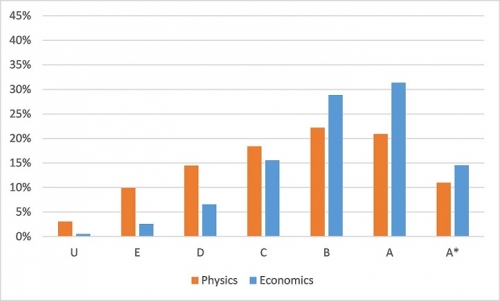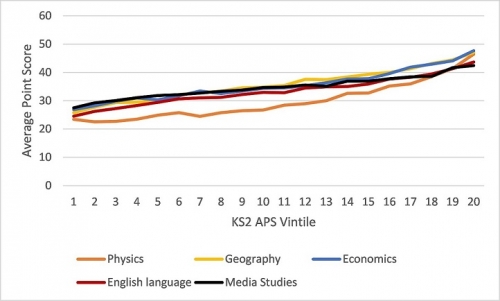So A-level General Studies will be no longer be available after 2016. As Ofqual have been reforming A-levels so-called “soft” subjects such as home economics and now General Studies have been dropped. But are some current A-levels really easier or harder than others?
In this blogpost, we look at national attainment in 2014 in five subjects which had broadly similar (between 19,000 and 29,000) numbers of entrants in state-funded schools:
- Economics
- English language
- Geography
- Media studies
- Physics
In the charts that follow, I look at A-level attainment based upon prior attainment at Key Stage 4. I divide all A-level entrants nationally into 20 evenly sized bands, or vintiles, based on their average point score (APS) in all qualifications (GCSEs and equivalents) achieved by the end of Key Stage 4.
Figure 1 shows that entrants in media studies and, to a lesser extent, English language tended to have lower prior attainment than entrants in economics and, especially, physics.
Figure 1: Number of entrants in A-levels by KS4 prior attainment, 2014

For each KS4 APS vintile I then calculate the average point score (APS) for each subject at A-level using a scale with 60 points for a grade A* pass down to 10 points for a grade E pass. Fails score 0 points.
Figure 2 reveals that the APS in media studies tends to be higher than that in other subjects when looked at this way.
At the 10th vintile, the APS in media studies is almost six points higher than that in economics – equivalent to more than half a grade.
The physics APS, meanwhile, is much lower than all other subjects. At the 10th vintile, the difference in APS between media studies and physics is more than 13 points, equivalent to more than a grade.
Overall, the APS in physics (35.3) is actually higher than that in media studies (32.3) but we would expect a higher level of attainment in physics given the prior attainment of entrants shown in Figure 1.
Figure 2: Mean A-level average point score by KS4 prior attainment, 2014

So is media studies really easier than other subjects? And is physics harder? Figure 2 certainly suggests so. For standards to be equivalent we would need a plausible explanation for Figure 2. Two suggestions might be that:
- Entrants differ in other ways that have an effect on subsequent outcomes, e.g. entrants in some subjects may be more motivated than entrants in other subjects; or
- The quality of teaching in some subjects is better than in others.
The second argument above is difficult, if not impossible, to test at present even with the volume of data we have at our disposal. We can, however, begin to examine the first. There were over 2,000 students who were entered in A-levels in both media studies and English language in 2014 and another 2,000 entered in A-levels in both physics and economics.
Students tended to achieve better grades in media studies than in English language (Figure 3) and in economics than in physics (Figure 4). Both charts would tend to lend support to the argument that media studies is presently easier than other subjects and that physics is presently harder.
Figure 3: Comparison of A-level grades achieved, students entered in A-levels in both media studies and English language, 2014

Figure 4: Comparison of A-level grades achieved, students entered in A-levels in both physics and economics, 2014

At present, outcomes in physics and the other sciences look too low relative to other subjects. This is not a new finding; Rob Coe and colleagues at Durham University undertook a much more comprehensive study in 2008 and concluded much the same thing.
But what if we look at progress from Key Stage 2 to A-level? In Figure 5 we replace the vintiles based on KS4 prior attainment from Figure 2 with vintiles based on KS2 prior attainment. This shows a slightly flatter (less steep) distribution for each subject, indicating a weaker relationship with prior attainment, and narrower gaps between subjects.
This may suggest that students who entered media studies at A-level tended to make less progress from Key Stage 2 to Key Stage 4 than those who entered physics. As a result, KS4 prior attainment for media studies entrants may under-estimate their potential to some degree.
Figure 5: Mean A-level average point score by KS2 prior attainment, 2014

Some of the gap in A-level grades conditional on KS4 prior attainment between entrants in physics and media studies may be due to variations in progress from Key Stage 2 to Key Stage 4, then.
The latter group tend to make less progress from KS2 to KS4, and so the chance to study a new subject may represent a fresh start.
Nonetheless, this probably does not explain all of the gap.
It is therefore to be hoped that the reforms to A-levels improves the consistency of grading between subjects. For while sciences are perceived as a hard option, more students are likely to be dissuaded from studying them.






Leave A Comment